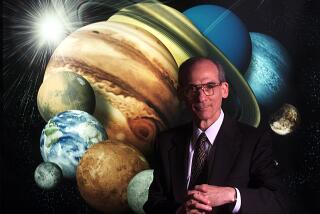The Voyagers’ Suburban Outpost
PASADENA — Little about the low-slung, red brick building at 460 Sierra Madre Villa Ave. suggests its purpose. The structure fronts a block of 1950s-vintage, ranch-style homes, with RVs parked in driveways and magnolias planted along the sidewalk. Down the street, there’s a Christian preschool; up the street, a branch library.
The front door opens to a maze of cubicles--the ubiquitous “work stations” of the modern American office. It is hardly a beehive. The sounds are of soft computer keystrokes and low-key conversations in a language that requires decoding, talk of “AUs” and “slews” and “sending up a load.”
“We are very routine these days,” said George Textor, the man in charge. “It is hard sometimes to tell anything is going on.”
The banality, though, is deceptive. The people who work amid the cubicles operate Voyager I and Voyager II, a pair of 16-year-old spacecraft that, before long, should become the first to escape the final strands of solar influence and break into interstellar space. In other words then, the main business of 460 Sierra Madre Villa has to do with poking deeper into the uncharted void of space than ever before. Very routine.
*
Launched in 1977, Voyager I and Voyager II once dominated NASA and especially its Jet Propulsion Laboratory in Pasadena. As the twin craft looped through the solar system, sending back remarkable photographs of Jupiter’s moon, Saturn’s rings and more, the project employed more than 300 scientists and technicians. When the explorers ran out of planets, the operation was moved off the main JPL facility and into a leased office building, a few miles south.
By now the Voyager staff has shrunk to 48 people, the budget to $12 million a year. A few old hands who worked on Voyager from before the launch remain, and they speak of the spacecraft as a parent might a child. Eyes twinkling, Werner Mattson, a 64-year-old who joined the project in 1975, described his emotional attachment to the spacecraft as “mighty. It really is--as strange as that may seem, that anyone can become that fond of a piece of hardware. But I am.”
The Voyagers initially were not expected to remain operative much longer than five years, but like the battery-operated bunny on television, they kept on going and going. . . . Their distance from Earth now is measured in astronomical units, or AUs. One AU equals the average distance between the Earth and sun, roughly 93 million miles. Voyager I is 51 AU out, while Voyager II is 38 AU. Commands once flashed to the spacecraft within seconds now take almost eight hours to deliver.
“If something shows up here that is catastrophic,” said John Tullius, who from his computer console at the Mission Control cubicle in essence “flies” the Voyagers, “it already has happened eight hours ago, and there is nothing we can do about it.”
Every 13 weeks, a new set of instructions is relayed to the spacecraft--”a load,” it is called. There might be new commands to redirect, or slew, the data-collecting instruments, but usually the changes are minimal. Tullius said: “They call this stage of the mission ‘interstellar cruise,’ and that is exactly what it is: a cruise.”
*
Since the Cold War ended, and with it the Space Race, a certain nervousness has enveloped NASA. There is a greater need to justify taxpayer money spent on missions to far-flung planets, as opposed to taxpayer money spent on nearby urban slums. In that context, the people here will talk of voluntary staff cutbacks and other cost-saving measures, of the rich harvest of science the Voyagers have yielded so far, and of the potential to learn more as the spacecraft pass through the so-called heliosphere.
“Voyager still has got a lot to do,” said Robert Poynter, a project scientist. “If it survives its budget problems, if it survives the electrical and mechanical failures that are likely to occur . . . we will see the edge of the solar system in a way that we won’t be able to repeat again in our lifetime.”
The Voyagers will go dark in a couple of decades, when their power runs out. Unless they bump into something unforeseen, however, their trajectories should carry them through the icy vacuum of space for centuries and beyond. Press them hard enough, and there are people at 460 Sierra Madre Villa who will admit that they daydream sometimes about this last, long leg of the mission.
Will the spacecraft be found some day? And by whom? Will the recordings they carry on board to explain their origin be understood? Such musings are not the stuff of hard science certainly, and they, and we, can only wonder about the answers. In a sense, however, it is precisely such wondering that both explains, and justifies, the entire exercise.







